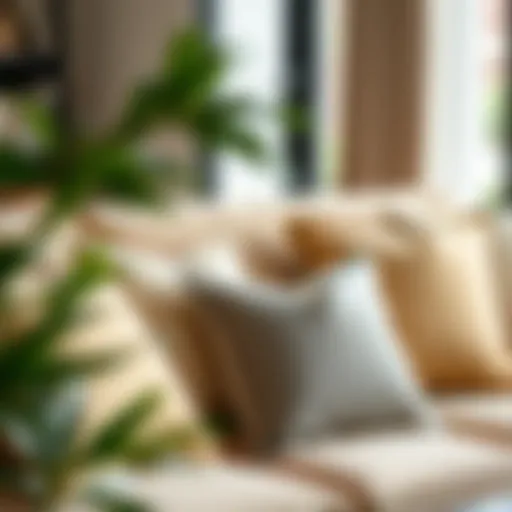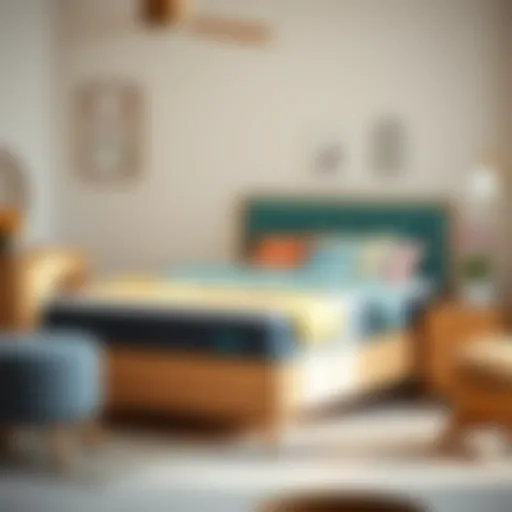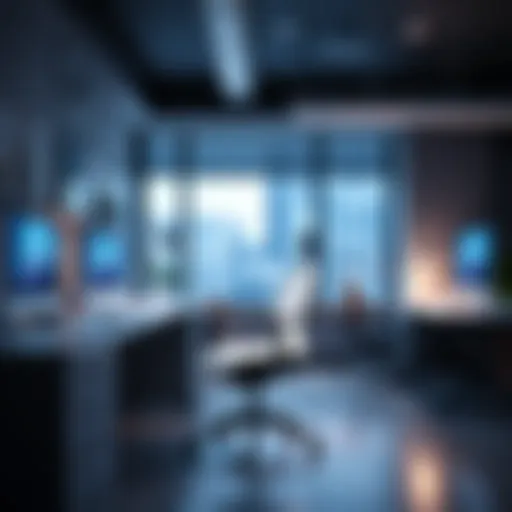Exploring Walldecore: Innovative Wall Decoration Ideas


Intro
Walls are more than boundaries within a home; they are blank canvases waiting to be infused with creativity and personality. The concept of walldecore revolves around utilizing these surfaces to reflect tastes and evoke emotions. Almost every homeowner can relate to the common struggle of making bare walls resonate with warmth and character. With the rise of modern interior design trends, more individuals aspire to create spaces that mirror their uniqueness.
This exploration into walldecore dives deep into the diverse techniques and materials that can transform a mundane wall into a striking focal point. From paint and wallpaper to art installations and textured surfaces, each choice carries psychological significance affecting mood and perception. Drawing inspiration from current trends, embracing innovative materials, and understanding color psychology can lead to well-decorated spaces that transcend mere aesthetics.
As we unravel the intricacies of wall decoration, we aim to offer practical insights for homeowners, interior decorators, and design enthusiasts. Familiarizing oneself with the trending styles aids in crafting an environment that radiates comfort and sophistication. This comprehensive guide does not solely highlight how to decorate walls but also emphasizes the emotional responses evoked through design choices.
Understanding how to incorporate distinctive elements into living spaces often contributes to a more harmonious home environment. In the following sections, we will delve into contemporary design trends, providing a close look at:
- What’s currently trending in walldecore, including popular colors, materials, and styles.
- Effective strategies for integrating these trends into personal spaces, considering both functionality and aesthetics.
With this roadmap in hand, the journey through walldecore promises to unveil the potential hiding behind every wall.
Understanding Walldecore
Walldecore represents a contemporary movement in the realm of interior design, focusing on how walls are not merely structural elements, but also vital canvases for expression. This section delves into the core essence of Walldecore, highlighting its significance for homeowners, designers, and enthusiasts alike. The emphasis lies on understanding how the thoughtful decoration of walls can transform the overall ambiance of a space, enhance personal style, and reflect one’s identity.
The Concept of Walldecore
At its essence, Walldecore is about embracing walls as a foundational aspect of interior aesthetics. It encompasses a blend of surrounding beauty, functionality, and personalization. When you step into a room, your eyes naturally gravitate towards the walls. Rather than leaving them bare or neglecting their potential, Walldecore encourages the exploration of various aspects like color, texture, and art. More than just a backdrop, walls give a voice to your living space.
Walls can take on numerous personas; they can exude warmth through earthy tones, evoke tranquility via soft pastels, or invigorate with bold patterns. Each wall can act as a narrative, telling visitors something unique about the homeowner’s taste, values, or experiences. This approach is particularly appealing for those seeking to create a truly distinctive environment.
To effectively harness the spirit of Walldecore, one might ask: How do I want my space to feel? Considering elements like balance, proportion, and rhythm in design—understanding Walldecore begins with introspection.
Historical Context
Tracing back the roots of wall decoration, the journey of Walldecore can be quite telling. Historically, walls have always been significant in various cultures. Think about ancient civilizations; frescoes adorned Roman villas, while intricate carvings graced the temples of the East. These decorations weren’t just for aesthetics; they served to communicate stories, beliefs, and social status.
Fast forward to the Renaissance, where wealthy patrons commissioned vast works of art on their walls, pushing the boundaries of expression. The key takeaway is that wall decoration has always played a central role in human history—adapting, evolving, yet continually serving as a canvas for personal and collective narratives.
In today’s context, Walldecore emerges from the need for self-expression in a world filled with bland corporate spaces and monotony. It represents a merge of historical appreciation with modern trends, aiming to reintroduce the personal touch of artistry into our living environments.
Cultural Variations
It’s crucial to acknowledge that Walldecore does not adhere to a one-size-fits-all approach and varies across cultures. In Japan, for example, the concept of Wabi-Sabi embraces imperfection and transience—often reflected in wall visuals with natural, unfinished materials or muted tones. Meanwhile, in Moroccan design, vibrant tile patterns and textures provide a rich tapestry, celebrating life and color with boldness.
From the intricate woodwork found in Scandinavian homes to the exquisite tapestries in Persian spaces, every culture offers unique perspectives on how walls contribute to overall aesthetics. Each adds a layer to the narrative of Walldecore, allowing an exploration of diversity in decor practices.
Ultimately, the beauty of Walldecore lies in its adaptability—no matter where you're from, you can find ways to incorporate these cultural principles into your home, creating something uniquely yours.
Understanding Walldecore sheds light on how walls, often overlooked, can play a transformative role in shaping our living experiences. By acknowledging the historical significance and cultural diversity of wall decoration, we are better equipped to make informed choices in our design journey.
By embracing the multifaceted approach to wall decoration, homeowners and designers can fully appreciate the impact of Walldecore and its potential to enhance both functionality and beauty within any space.
Significance of Walls in Interior Design
Walls aren't just the backdrop of a room; they're a canvas for expression, practicality, and interaction within a space. This section explores various facets of wall design that shape the overall experience of a home, emphasizing their dual role as structural entities and dynamic decor elements. Recognizing the significance of walls assists homeowners, designers, and decorators in creating spaces that resonate personally and functionally.
Structural versus Decorative Functions
Walls primarily serve two essential roles in interior design: structural integrity and decorative allure. Structurally, walls provide the framework that supports roofs and ceilings, maintaining the building's stability. However, as homes evolve into personal sanctuaries, these barriers transform into vital components of decor.
The transition from merely structural to decorative can be illustrated in several ways:
- Material Selection: The choice of materials—be it drywall, plaster, or natural stone—affects both aesthetics and functionality. For instance, textured walls can create a rustic charm, while sleek surfaces may invoke modern minimalism.
- Color Application: Paint and wallpaper allow for an array of visual expressions. Bright colors can invigorate a space, while muted tones encourage tranquility. Each hue interacts with light and shadows, shaping the perception of space.
In essence, understanding this interplay between structure and decor assists in achieving harmony. A wall that supports while also enhancing visual interest can elevate a space from being simply a room to a vibrant environment.
Creating Atmosphere through Design
The walls of a room play a pivotal role in fostering atmosphere. Thoughtful wall design can transport individuals from the mundane to the extraordinary. For instance, a cozy reading nook may feature soft, warm colors that invite relaxation, while a home office could utilize energizing accent walls to boost productivity.
Key elements that contribute to atmosphere include:
- Layered Textures: Wall finishes impact how rooms feel. Rough surfaces might imbue a nostalgic vibe, while smooth, glossy finishes could evoke a sense of elegance or modernity.
- Artwork and Decor: The curated choice of wall decor—paintings, photographs, or even wall-mounted sculptures—offers a personal touch, easily transforming a space's mood.
It’s also crucial to consider light placement when designing walls, as the way natural and artificial light interacts with surfaces significantly influences overall ambience. Here, spatial awareness contributes greatly: how a space is divided, where walls are placed, and how they guide the flow within a home are essential to crafting an inviting atmosphere.
Psychological Impact of Wall Decor
It's fascinating how walls can affect our psychology. The decor choices we make not only reflect our personal style but can significantly influence our emotions and behavior. Researchers have noted that colors, textures, and patterns can evoke specific feelings, potentially altering our mood.


Consider the following examples of how wall decor impacts psychological well-being:
- Color Psychology: Warm colors like reds and oranges can stimulate energy and enthusiasm, while cooler tones like blues and greens promote calmness and serenity. Choosing the right palette is crucial in spaces meant for relaxation or social interaction.
- Visual Stimuli: Art on walls can invoke memories and feelings, grounding spaces in a unique story or theme. A vibrant gallery wall filled with joyous moments might uplift spirits and foster connection among residents.
By being mindful of these psychological effects, homeowners can create atmospheres that not only beautify their spaces but also enhance their daily lives, providing comfort, inspiration, or motivation as needed.
"Walls provide both the structure and spirit of our spaces; their impact is felt long after the paint dries."
The interplay of structural and decorative functions, the atmosphere shaped through design, and the profound psychological influence of wall decor underscore the walls' significance in interior design. Approaching wall decoration with intention can ensure that every space not just contains life but breathes it vibrantly.
Material Considerations
Understanding the materials involved in walldecore is crucial to the overall success of any wall decoration project. The choice of materials not only shapes the visual outlook but also influences the ambiance and functionality of a space. Selecting the right materials can enhance both the aesthetic appeal and the practical application of a wall design.
Paint and Wallpaper
Paint and wallpaper have long been staples in the world of interior design. Both offer flexibility and style, but they serve different purposes. While paint can provide a clean canvas and allow for remarkable color versatility, wallpaper contributes texture and can create intricate patterns that paint simply cannot match.
- Benefits of Paint
- Benefits of Wallpaper
- Quick application and drying time.
- Easier touch-ups and maintenance.
- Broad range of colors available.
- Unique designs, textures, and luxury finishes.
- Can add depth to a room.
- Some wallpapers offer durability and washability.
However, one must consider factors like the room's moisture levels and floor traffic. For instance, in humid locations like bathrooms, specialized paint or vinyl wallpaper is a smart choice. Ultimately, both options can work together harmoniously, setting the right tone for each space.
Wood and Natural Materials
Wood and natural materials bring warmth and character, making them perfect choices for creating a cozy atmosphere. The tactile sensation of wood grain and the organic feel of stone or bamboo often impart a timeless elegance.
- Advantages of Wood
- Considerations
- Durable and can last for generations.
- Offers rich, organic finishes.
- Absorbs sound, reducing potential noise levels.
- Requires regular maintenance, such as varnishing.
- Risk of warping in high moisture.
Natural materials, such as jute or cork, are gaining popularity as sustainable choices. They bring unique nuances and can contribute to the overall harmony of a room while promoting a healthy living environment.
Textiles and Fabrics
Textiles provide an opportunity to layer a design with both color and feel. Wall hangings, fabric panels, or drapes can soften a space or add visual warmth. Not just decorative, textiles can improve acoustics and comfort.
Some key considerations include:
- Durability - Choose high-quality fabrics to withstand wear and tear.
- Cleanability - Opt for materials that are easy to maintain, especially in homes with kids or pets.
A wall adorned with fabric can resonate with a feeling of comfort and make a bold statement without overwhelming the senses. A tapestry, for instance, can serve both as artwork and a focal point that draws the eye.
Metal and Glass Elements
Metal and glass elements provide that modern edge, enabling the creation of dynamic contrasts against softer materials like paint and textiles. These materials can effortlessly elevate a space, reflecting light and introducing sleek lines.
- Uses of Metal
- Considerations for Glass
- Stainless steel or aluminum can create contemporary accent pieces.
- Wrought iron elements can offer a rustic charm.
- Glass options provide an illusion of space and openness.
- Careful attention is needed to avoid excessive glare or compromising privacy.
Metals and glass can easily intermingle with other materials—think of how a wooden frame complements a glass artwork or a metal sculpture paired with a textured wall. This synergy promotes a well-rounded environment that is inviting and visually engaging.
In all, selecting the right materials in walldecore goes beyond mere aesthetics. It's about making intelligent choices that align with the functionality desired and the feelings one aims to evoke within a space.
Techniques for Wall Decoration
Decorating your walls isn't just about splashing some paint on and calling it a day. It involves a thoughtful selection of techniques that resonate with the overall design of your space. The ways in which walls are decorated can transform a room, making it feel larger, cozier, or even more vibrant. Finding the right techniques is crucial because they can elevate the atmosphere, defining how the space is experienced. With many options available, each technique offers unique benefits and considerations that can cater to your personal style and practical needs.
Murals and Artistic Expressions
Murals are not just background wallpaper; they are powerful statements. Imagine walking into a room where a verdant landscape sprawls across the wall, or abstract shapes evoke a sense of motion. Murals can capture attention more than any standard decoration. They allow homeowners to express their personality or theme in a way that few other elements can.
When contemplating a mural, there are several routes to consider:
- Commissioning an Artist: Hiring a professional brings unique flair—an artist’s vision can turn an ordinary wall into a stunning focal point.
- DIY Options: With online tutorials and kits available, crafting your own mural can be both cost-effective and fun. Plus, it becomes a personal project imbued with memories and sentiments.
However, it’s important to reflect on the scale and the colors involved in the mural; a wrong choice can overwhelm or dim the room.
Incorporating artistic expressions shouldn’t be rushed. Take the time to plan and visualize how the mural will harmonize with existing decor.


Gallery Walls: Practical Steps
Gallery walls seem to be the darling of design blogs everywhere, and for good reason. They tell a story uniquely yours, showcasing photos, artwork, or even mirrors. While they may look effortless, creating a gallery wall does require some strategy.
To start, here’s a practical approach:
- Collect Your Pieces: Gather a variety of art and prints. Mixing sizes and formats can also create visual intrigue.
- Layout Planning: Lay everything out on the floor first or use painter's tape to outline the arrangement on the wall. This allows for adjustments before making any permanent decisions.
- Fix Them Up: Use proper mounting hardware to ensure stability, especially if items are heavier. Hanging with a mix of frames or going frame-less can also contribute to a more eclectic or uniform look, depending on your aspiration.
The beauty of gallery walls is that they can evolve over time. You can swap out pieces, keeping the decor fresh and reflective of your latest interests or travels.
Accent Walls: Choosing the Right Approach
Accent walls can redefine a room's dynamics. Choosing one wall to stand out allows for bold colors or textures that might otherwise be overwhelming. Before diving into the selection process, think about the mood you want to evoke.
- Color Choices: A deep navy can instill calmness, while a fiery red might energize.
- Texture Options: Consider wood panels or textured paint for added depth.
An accent wall is often simpler and more cost-effective than a complete overhaul. It’s a small commitment that can yield striking results. Just remember, the accent wall should harmonize, not clash, with the rest of the room’s palette.
Integrating Shelving and Storage Solutions
Incorporating shelves into wall decor can serve dual purposes—style and function. Not just for storage, shelves can present books, trinkets, or plants, adding layers to your decor.
- Floating Shelves: They give a modern edge while maximizing floor space. Plus, they can maintain clean lines, crucial in minimalist designs.
- Built-in Shelves: A fully integrated design can enhance architectural features and make a statement of sophistication.
Balancing functional shelving with art is an art in itself. Avoid overloading shelves; instead, leave some empty space to let individual pieces shine. Guests will appreciate a well-thought-out display, combining both utility and decoration seamlessly.
Creating a stunning wall is not merely an aesthetic exercise; it requires a balance of creativity and practicality that speaks to personal expression.
Harmonizing Design Elements
Harmonizing design elements in interior spaces is crucial for creating a cohesive and inviting atmosphere. When walls are thoughtfully decorated, they become more than just boundaries; they blend with furnishings and decor to form a unified aesthetic. Considering color, texture, and function not only enhances the visual appeal but also influences how a space feels and functions.
Color Theory and Walls
Color is arguably the most powerful tool in design. It can energize, calm, or even inspire feelings of nostalgia. When working with walls, understanding color theory helps greatly in making informed choices. Each hue carries its own psychological weight. For example, shades of blue can create a sense of tranquility, making them perfect for bedrooms. Conversely, bold reds can invigorate a space, often seen in dining areas to stimulate appetite and conversation.
Considerations for color selection include:
- Room Purpose: The intended use informs your color choice; serene tones for study areas, vibrant shades for playrooms.
- Lighting: Natural and artificial light can alter how colors appear, so testing swatches in different conditions is wise.
- Harmonious Combinations: Utilize complementary colors to promote cohesiveness throughout the space.
"Color is the keyboard, the eyes are the harmonies, the soul is the piano with many strings." — Wassily Kandinsky
Texture and Finish Variations
Textures add a layer of richness and complexity to wall decor. They engage touch and sight, creating depth and interest. Mixing different textures, like pairing smooth paint with rough wooden panels, can make a space feel dynamic. Furthermore, finishing options—from matte to gloss—also affect how colors are perceived and how much light reflects.
Factors to ponder:*
- Material Interplay: Combining various materials can break visual monotony. An accent wall made of reclaimed wood can serve as a stunning contrast to sleek, painted surfaces.
- Finish Type: Matte finishes tend to absorb light, offering a cozy vibe, while glossy finishes reflect light and can make spaces appear larger.
- Layering Textures: Using wall hangings, textiles, or decals can introduce different textures without the commitment of permanent changes.
Balancing Functionality and Aesthetics
When harmonizing design elements, it is essential to consider both functionality and aesthetic appeal. While a visually attractive space draws the eye, it should also serve its intended purpose. For instance, walls may need to accommodate shelving for books or artworks while still looking polished.
To strike the right balance, consider the following tips:*
- Identify Primary Needs: Is storage a priority? Are you looking for more visual impact? Making these determinations can influence your design direction.
- Multi-functional Decor: Items like decorative shelving not only beautify walls but also provide practical storage solutions.
- Assess User Interaction: Understand how the space will be used daily. High-traffic areas may need more durable finishes while low-traffic spaces can flaunt delicate accents.
By synthesizing these elements—color, texture, functionality—it’s possible to achieve a space that is visually pleasing yet perfectly practical. Engaging in harmonious design doesn’t just beautify your home; it enriches experiences, making every room a unique exploration.
Contemporary Trends in Walldecore
In recent years, the approach to wall decoration has seen a significant evolution, reflecting changing tastes, lifestyles, and a greater emphasis on sustainability and functionality. Understanding contemporary trends in walldecore is essential for homeowners and designers alike, as these trends not only influence visual aesthetics but also contribute to the overall ambiance and usability of a space. Today's walls have become canvases for self-expression, melding creativity with practical design, and addressing deeper psychological needs.
Sustainability in Wall Decor
The push towards sustainability has permeated almost every aspect of design—and walldecore is no exception. Homeowners are increasingly drawn to materials that are environmentally friendly, recyclable, or sourced from sustainable practices. This trend is not just about being eco-conscious; it's about creating a healthier living environment.
Some key elements of sustainable wall decor include:
- Recycled materials: Wallpapers made from recycled paper or fabrics and reclaimed wood paneling are hitting the market hard. These options not only look appealing but also minimize waste.
- Low-VOC paints: For those who prefer a splash of color, opting for low-VOC (volatile organic compounds) paints can enhance air quality, avoiding harmful emissions typically associated with conventional paints.
- Natural fiber textiles: Rugs or wall hangings made from jute, cotton, or hemp add warmth without sacrificing the environment, bridging the gap between comfort and consciousness.
Adopting sustainable practices in walldecore can ultimately lead to healthier spaces that reflect a homeowner's values. When walls tell a story about ecological responsibility, they hold more meaning—transforming mere decor into a personal statement.
"A sustainable home is not just an aesthetic choice; it's an investment in the future."


Biophilic Design Principles
The allure of incorporating nature into our living spaces is becoming ever so important, as urbanization continues to create stark barriers between us and the natural world. Biophilic design principles offer an effective way to instill a sense of calm and connectivity of nature within home interiors, particularly on walls. The focus on creating spaces that are in harmony with nature encompasses various strategies:
- Living walls: Vertical gardens are sprouting up in homes, where a section of a wall is dedicated to an assembly of plants, providing both beauty and improved air quality.
- Natural textures: Using stone, wood, or even clay enhances tactile experience, bridging the gap between indoor and outdoor environments.
- Artwork inspired by nature: From prints of landscapes to photographs capturing flora and fauna, artwork that reflects natural themes can evoke a sense of tranquility.
Integrating biophilic elements into walldecore not only beautifies a space but also promotes emotional well-being and reduces stress. Essentially, these principles remind us that nature can be both a visual feast and an emotional balm.
Minimalism versus Maximalism
The age-old debate between minimalism and maximalism persists in contemporary walldecore trends. Each approach has its advocates and appeals to different sensibilities. Understanding these philosophies can aid homeowners in making smarter design choices that resonate with their style preferences and lifestyles.
Minimalism focuses on simplicity and functionality. Key characteristics include:
- Neutral color palettes: Whites, beiges, and soft gray hues define a minimalist space, creating a calm atmosphere that helps to declutter the mind.
- Streamlined furniture: Functional furniture with clean lines keeps surfaces clear, allowing for more open and airy wall space to shine.
- Fewer decorative elements: The mantra "less is more" reigns supreme, meaning every piece must serve a purpose or bring joy.
On the flip side, maximalism celebrates abundance and individuality. Its hallmarks often are:
- Vibrant colors: Bold, contrasting colors energize a space and can transform an ordinary wall into a statement piece.
- Layered textures: Mixing materials and patterns, from textiles to art, creates a rich narrative, engaging viewers at every glance.
- Personality-driven decor: Each wall can serve as a gallery, showcasing personal collections, photographs, or art that resonate with the inhabitants, telling unique stories.
The choice between minimalism and maximalism ultimately hinges on individual preferences and lifestyle. A harmonious balance between the two can yield a truly bespoke environment, where walls not only please the eye but also reflect the soul of the home.
Overall, staying attuned to these contemporary trends in walldecore not only enhances aesthetic appeal but also elevates the home environment into a space that embodies sustainability, a love for nature, and personal touches that make it truly one’s own.
Practical Tips for Homeowners
Decorating your walls isn’t just about slapping paint on and calling it a day. Understanding how to approach walldecore can make a world of difference. This section dives into practical, hands-on advice that can empower homeowners to make informed decisions and avoid common pitfalls. Optimizing wall space is crucial because it reflects your personality and affects how your living environment feels.
Assessing Your Space
Before diving headfirst into the world of wall decoration, it’s essential to assess the space you want to upgrade. Each room serves a unique purpose, and the wall decor should complement that functionality.
- Scale Matters: Consider the size of the space. High ceilings call for tall artworks or textures that draw the eye up, while intimate areas may benefit from smaller, more personal pieces.
- Functionality: Think about how the room is used. In a living room, which is often a gathering spot, opt for warm colors and inviting decoration. In a home office, decks of soothing tones can enhance focus.
- Natural Light: Examine how natural light plays within the space. Light shades can brighten up darker corners, while bold colors may enhance sunlit areas.
One useful approach is to sketch the room on paper and visualize where you want your decor elements. Doing so allows you to consider every nook and cranny.
Budgeting for Walldecore Projects
Setting a budget before starting any decorating job can save you from unexpected expenses. The costs can vary widely; that’s why having a clear financial plan is vital.
- Know Your Priorities: Determine what aspects of walldecore mean the most to you. Is it custom art, unique textures, or simply a fresh coat of paint? Listing them can help you allocate where the money goes.
- Shop Smart: Browse both retail and online stores, but keep an eye on potential sale opportunities like clearance items or seasonal discounts. Websites like Wayfair or local thrift shops can often yield interesting finds on a budget.
- DIY Possibilities: Many aspects of walldecore—like stenciling or even creating your own art—can dramatically cut costs. A little creativity can go a long way.
Remember, a budget isn't meant to limit your creativity. It helps focus your efforts and ensures you can achieve your desired look without financial strain.
DIY versus Professional Help
Deciding between tackling your wall decor project yourself or hiring a professional can feel daunting. Both routes offer distinct advantages.
- DIY:
- Professional Help:
- Cost-Effective: Doing it yourself can save money, and nothing beats the pride of having created it.
- Flexibility: You control your own timeframe and the style.
- Expertise: While DIY can be rewarding, professionals bring experience and may have insights that can elevate your ideas.
- Time-Saving: If your schedule is already packed, handing off certain decorating duties can streamline the process and ensure it’s done right.
Ultimately, the choice hinges on confidence, time, and budget. Sometimes, a hybrid approach works well—handle simpler elements yourself and hire out the more complex tasks.
Good design shouldn't be an unattainable dream. With solid planning, anyone can make their walls work wonders.
By following these practical tips, homeowners can approach walldecore with a thoughtful and effective strategy, ensuring their living spaces are not just adorned, but resonate with the essence of their lifestyle. This groundwork sets the stage for creating a home that is as unique as its residents.
Epilogue
The discussion surrounding walldecore serves as an essential framework for understanding how wall decoration shapes both aesthetics and atmosphere in modern interiors. This article emphasizes the intricate layers of wall decoration, elucidating the unique relationship between walls and the spaces they inhabit. Recognizing the varying functions of wall decor—from purely decorative to highly functional—shines a light on the thoughtful integration of design principles that can elevate everyday environments into harmonious living spaces.
Future Directions in Walldecore
Looking ahead, walldecore is poised to evolve in multiple exciting ways. As we see a growing awareness of sustainability in design, more homeowners and designers are likely to opt for eco-friendly materials and practices. This shift will lead to increased incorporation of reclaimed wood, natural paints, and upcycled textiles, promoting a circular economy within the decor space.
Moreover, the rise of smart home technology presents a remarkable opportunity for innovative wall solutions. Imagine walls embedded with interactive screens or adjustable features that can morph their appearance with just a swipe on a smartphone. This presents a wealth of potential for customization, making the home even more of a personalized refuge.
Key Trends to Watch:
- Sustainable Materials: Adoption of bio-based paints and recycled surfaces.
- Technology Integration: Smart walls with flexibility in design options.
- Cultural Inspirations: A blend of vintage and modern styles reflecting diverse backgrounds.
Enduring Influence of Wall Design
Wall design has been a staple in interior decoration since time immemorial, and its influence remains as powerful as ever. From the tapestries of ancient civilizations to contemporary digital prints, walls are a canvas for personal expression, culture, and storytelling. They convey moods, evoke memories, and act as silent witnesses to the daily lives of inhabitants.
Understanding the historical significance of wall decor can give contemporary designers and homeowners crucial insights into the choices they make today. A thoughtfully decorated wall isn't just about beauty; it's about creating a narrative that resonates with the inhabitants and visitors alike.
In summary, the future of walldecore beckons a balance of innovation and tradition, as individuals seek spaces that not only reflect their identity but also provide comfort and inspiration. By embracing these evolving trends, we can ensure that our wall designs do not merely adorn spaces, but also enrich lives.















